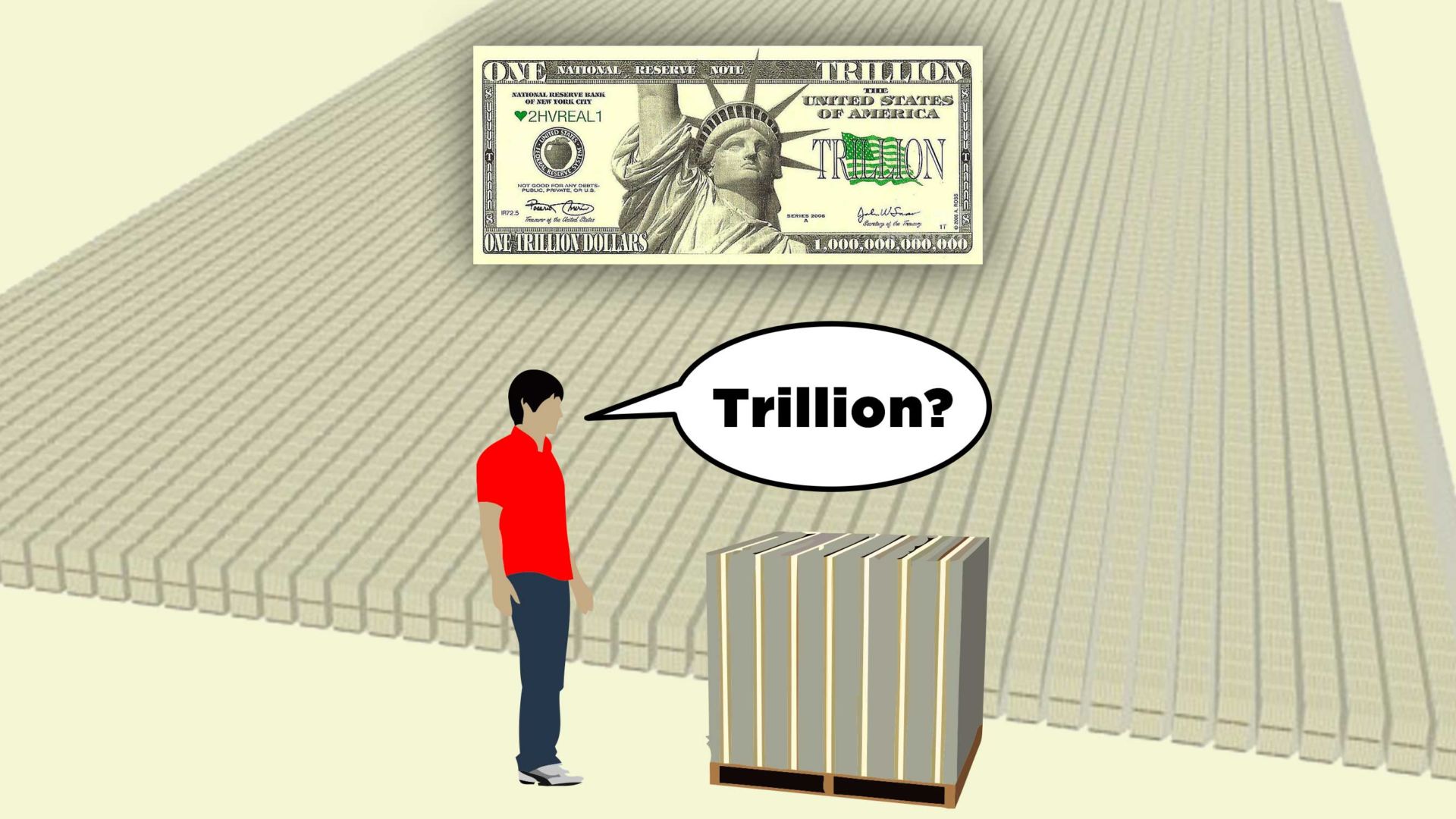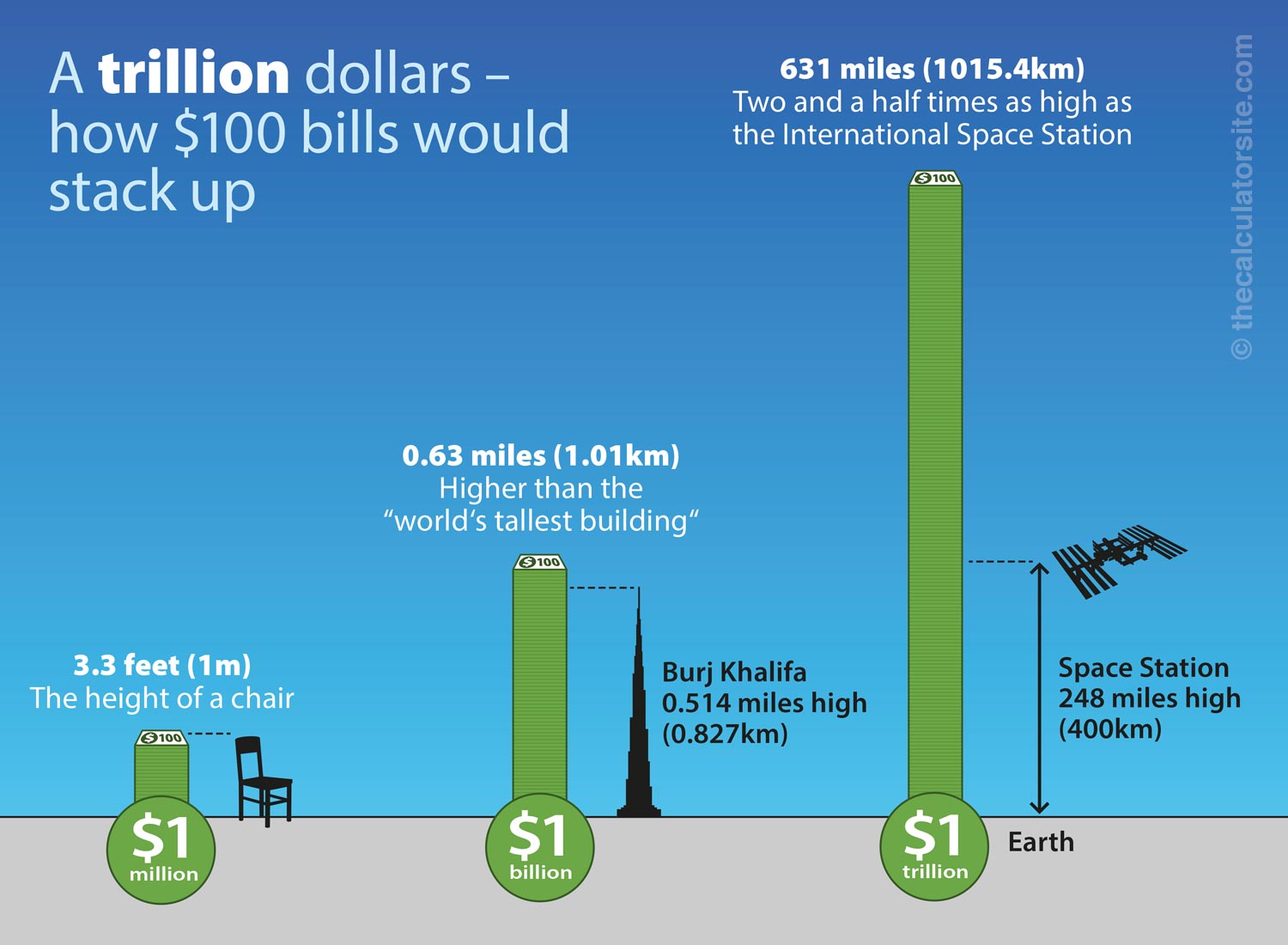What's Above Trillion? Exploring The Mind-Blowing Numbers Beyond
When you hear the word "trillion," it sounds like a massive number, right? But guess what? The universe of numbers doesn’t stop there. There's a whole lot more beyond trillion, and today, we're diving deep into this crazy world of big numbers. If you think trillion is big, wait till you discover what’s above it. Prepare to have your mind blown!
You might be thinking, "Why do we even need numbers bigger than a trillion?" Well, buckle up, because the answer is more fascinating than you'd imagine. From astronomical distances to the tiniest particles in the universe, these numbers play a crucial role in understanding the world around us. And no, we're not just talking about money here—although that would be fun too!
So, let's take a journey into the land of big numbers. Whether you're a math geek, a science enthusiast, or just someone who’s curious about how big things can get, this article is for you. By the end of it, you'll have a whole new appreciation for the vastness of the numerical universe. Ready? Let's go!
Understanding the Scale of a Trillion
Before we jump into what's above a trillion, let's first wrap our heads around what a trillion actually means. A trillion is a 1 followed by 12 zeros, or 1,000,000,000,000. To put that into perspective, if you counted one number per second, it would take you about 32,000 years to reach a trillion. Crazy, right? But as big as a trillion is, it's just the beginning of the number game.
Why Knowing About Numbers Bigger Than Trillion Matters
Now, you might be wondering, "Why do we even care about numbers bigger than a trillion?" Well, here's the deal: these numbers aren’t just abstract concepts. They’re essential in fields like physics, astronomy, and even economics. For example, when scientists measure the distance between stars or calculate the number of atoms in the universe, they’re dealing with numbers way beyond a trillion.
Plus, understanding these numbers helps us comprehend the scale of the universe and our place in it. It’s like looking at a map of the cosmos and realizing just how small we really are. So, while it might seem like a fun intellectual exercise, it’s actually pretty important stuff.
- Discover The Appeal Of Orlando Melbourne International Airport
- Unlock Your Potential With The Catalyst Club
What Comes After Trillion?
Alright, so what’s above a trillion? Drumroll, please… The next number in line is quadrillion. A quadrillion is a 1 followed by 15 zeros, or 1,000,000,000,000,000. That’s a whole lot of zeros, and it’s hard to even wrap your head around how big that number is. But don’t worry, we’ll break it down for you.
Breaking Down Quadrillion
If you’re still trying to grasp the concept of quadrillion, here’s a fun fact: if you stacked a quadrillion dollar bills on top of each other, the stack would reach all the way to the moon and back… 8 times! Mind = blown. Quadrillion is used in various scientific calculations, especially when dealing with massive quantities like the number of cells in the human body or the amount of data processed by the internet every day.
Quintillion: The Next Level
But wait, there’s more! After quadrillion comes quintillion. A quintillion is a 1 followed by 18 zeros, or 1,000,000,000,000,000,000. This is where things start getting really wild. Quintillion is often used in astronomy to measure things like the number of stars in the Milky Way or the amount of water on Earth. It’s a number so big that it’s almost impossible to fully comprehend.
Real-World Examples of Quintillion
Let’s bring quintillion down to Earth with some real-world examples. Did you know that there are approximately 7.5 quintillion grains of sand on Earth? Or that the human brain has around 100 quintillion synapses? These numbers are everywhere, even if we don’t always realize it. They help us make sense of the world around us, even when that world seems infinitely vast.
Sextillion and Beyond
Still with us? Great! Because we’re not done yet. After quintillion comes sextillion, which is a 1 followed by 21 zeros. And after that? Well, the numbers just keep getting bigger: septillion, octillion, nonillion, and so on. It’s like a never-ending staircase of zeros, and each step takes us further into the realm of the unimaginably large.
The Importance of These Big Numbers
Why do we need all these big numbers? Well, they’re essential for understanding the universe. From the smallest subatomic particles to the largest galaxies, these numbers help scientists make sense of the world. They’re also used in technology, medicine, and even finance. So, while they might seem abstract, they have real-world applications that affect our daily lives.
How Do These Numbers Affect Our Lives?
Now, you might be thinking, "How do these big numbers actually affect me?" Well, here’s the thing: they affect us in ways we might not even realize. For example, when you use your smartphone, you’re dealing with data that’s measured in petabytes, which is a multiple of a quadrillion. Or when scientists develop new medicines, they’re working with numbers that are on the scale of quintillions or even sextillions.
Everyday Applications of Big Numbers
Let’s break it down with some everyday examples. When you upload a video to YouTube, it gets stored in a data center that processes information on the scale of exabytes, which is a multiple of a quintillion. Or when you use GPS to navigate, the satellites are calculating distances that are measured in quadrillions of meters. These numbers are everywhere, even if we don’t always see them.
The History of Big Numbers
Believe it or not, humans have been fascinated by big numbers for centuries. Ancient civilizations like the Greeks and Romans had their own ways of expressing large quantities, and over time, our understanding of numbers has evolved. Today, we have a whole system for naming numbers beyond a trillion, and it’s all thanks to the work of mathematicians and scientists throughout history.
Key Milestones in the Development of Big Numbers
- Around 300 BCE, the Greek mathematician Archimedes wrote a treatise called "The Sand Reckoner," where he calculated the number of grains of sand that could fit in the universe.
- In the 1600s, the French mathematician Pierre de Fermat developed the concept of exponents, which allowed us to express numbers with even more zeros.
- In the 20th century, scientists like Albert Einstein used big numbers to describe the universe, from the tiniest particles to the largest galaxies.
Fun Facts About Big Numbers
Here are some fun facts about big numbers that might surprise you:
- The number googol, which is a 1 followed by 100 zeros, was actually named by a nine-year-old boy in the 1930s.
- The largest number ever used in a mathematical proof is called Graham’s number, and it’s so big that it can’t even be written down in standard notation.
- There are more stars in the universe than grains of sand on all the beaches on Earth, and both of those numbers are in the quintillions.
The Future of Big Numbers
As technology continues to advance, our understanding of big numbers will only grow. From quantum computing to space exploration, the future is full of possibilities when it comes to working with these massive quantities. Who knows? Maybe one day we’ll discover numbers so big that they make a trillion look like pocket change.
What’s Next in the World of Numbers?
Scientists are already working on new ways to express and understand big numbers. For example, researchers are exploring the concept of infinity and how it relates to the universe. They’re also developing new technologies that can handle data on the scale of sextillions or even septillions. The future of numbers is bright, and it’s only going to get more exciting.
Conclusion
So, there you have it—the world of numbers beyond a trillion. From quadrillion to quintillion and beyond, these numbers help us understand the universe in ways we never thought possible. Whether you’re a math whiz or just someone who’s curious about the world, there’s something fascinating about these big numbers.
Now that you know what’s above a trillion, why not share this article with your friends? Or better yet, leave a comment and let us know what you think. Who knows? Maybe you’ll discover the next big number yourself!
Table of Contents
- Understanding the Scale of a Trillion
- Why Knowing About Numbers Bigger Than Trillion Matters
- What Comes After Trillion?
- Breaking Down Quadrillion
- Quintillion: The Next Level
- Real-World Examples of Quintillion
- Sextillion and Beyond
- The Importance of These Big Numbers
- How Do These Numbers Affect Our Lives?
- Everyday Applications of Big Numbers
- The History of Big Numbers
- Key Milestones in the Development of Big Numbers
- Fun Facts About Big Numbers
- The Future of Big Numbers
- What’s Next in the World of Numbers?
- Conclusion



Detail Author:
- Name : Mr. Timmy Dickinson
- Username : qdaniel
- Email : darlene.blanda@hotmail.com
- Birthdate : 1996-02-23
- Address : 9278 Abernathy Track Bergemouth, OK 84648
- Phone : 1-269-578-9853
- Company : Abernathy, Breitenberg and Kirlin
- Job : Nursery Worker
- Bio : Voluptas eaque ea repellendus rem. Error laborum fugit vero delectus itaque et asperiores. Illo nulla fugit accusamus nemo unde omnis. Enim voluptatem quia quia maiores et est.
Socials
tiktok:
- url : https://tiktok.com/@marlee_moore
- username : marlee_moore
- bio : Quam dolores minus quibusdam voluptas ut. Sunt eius fugit eos nam optio.
- followers : 4941
- following : 1680
instagram:
- url : https://instagram.com/marleemoore
- username : marleemoore
- bio : Quaerat dolore eaque cumque sit nulla ipsam. Et voluptas atque corporis cupiditate iusto totam id.
- followers : 5000
- following : 1343
linkedin:
- url : https://linkedin.com/in/marlee.moore
- username : marlee.moore
- bio : Inventore consequatur non laborum ut nam.
- followers : 3440
- following : 2816